-
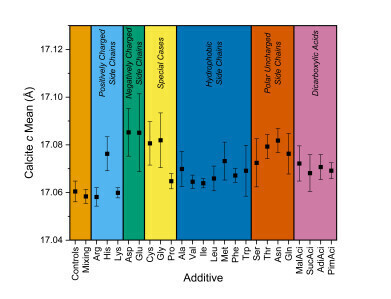 This graph shows how affected the structure of calcite is by different additives. The additives are mainly amino acids – similar to the additives used by nature to make calcium carbonate. Some additives make the calcite structure bigger as they can be incorporated in the structure, and we see this by looking at the axis on the left – the higher up a data point is, the more it is affected. (Credit: Diamond)
This graph shows how affected the structure of calcite is by different additives. The additives are mainly amino acids – similar to the additives used by nature to make calcium carbonate. Some additives make the calcite structure bigger as they can be incorporated in the structure, and we see this by looking at the axis on the left – the higher up a data point is, the more it is affected. (Credit: Diamond) -
.jpg) Beamline L11 (credit: Diamond)
Beamline L11 (credit: Diamond) -
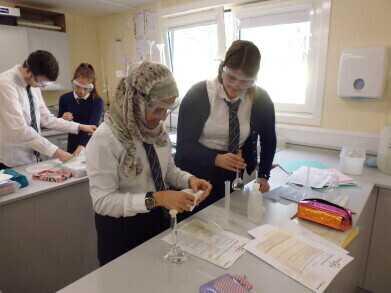
-
.jpg)
-
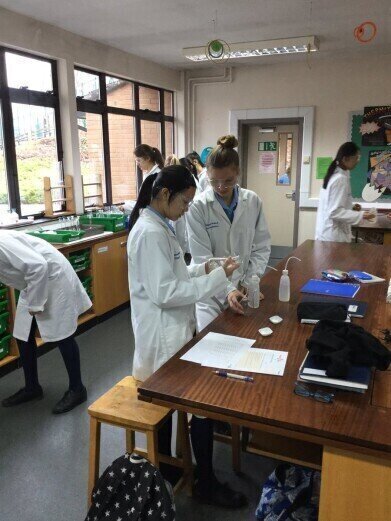
-
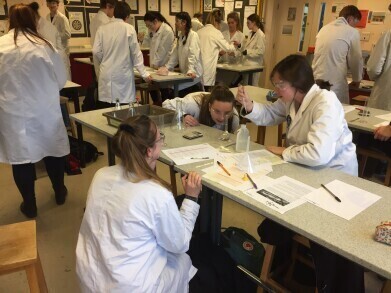 Various schools around the UK took part in the Citizen Science Project
Various schools around the UK took part in the Citizen Science Project -
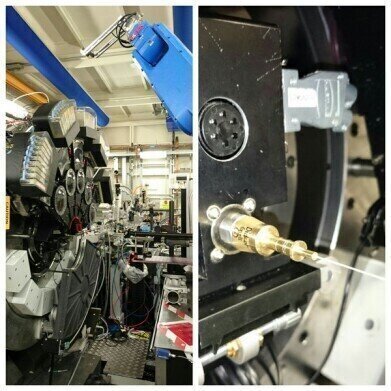 Beamline l11 at Diamond LIght Source (Credit: Diamond)
Beamline l11 at Diamond LIght Source (Credit: Diamond)
News & Views
Calcium carbonate study highlights benefits of citizen science engagement
Feb 21 2024
Project M, an unprecedented School Citizen Science Project involving over 1000 scientists, 800 samples and 110 UK secondary schools, has collectively produced a giant set of results from a systematic study of calcium carbonate samples. The school citizen scientists collaborated with a team at Diamond Light Source to discover how additives can affect the formation of calcium carbonate produced, thus also its properties and the importance of this for manufacturing applications. A study of this scale has never been completed anywhere else in the world and the results have now been published by the Royal Society of Chemistry(1).
Lead authors Claire Murray, Visiting Scientist at Diamond and Julia Parker, Diamond Principal Beamline Scientist and an expert in calcium carbonate science who conceptualised the project, explained that despite nature’s ability to precisely control calcium carbonate formation in shells and skeletons, laboratories around the world are often unable to exact the same level of control over how calcium carbonate forms. “Nature uses molecules like amino acids and proteins to direct the formation of calcium carbonate, so we were interested in discovering how some of these molecules affect the calcium carbonate that we make in the lab.”
Determining calcium carbonate forms
Project M engaged the students and teachers as scientists, who made samples of calcium carbonate under varying conditions with different additives. 800 of these samples were then analysed in just 24 hours in April 2017 using the X-ray powder diffraction technique at beamline I11 at Diamond, which can determine the mineral’s three main forms, or polymorphs - vaterite, calcite and aragonite.
The experiment involved preparing and mixing solutions to form a calcium carbonate powder. Each school had a set of 10 powdered samples to make: these included control samples to help standardise the experiment and other samples increasing the amount of additive they were using, or increasing the length of time they mixed the solutions. Each set of samples were planned to be repeated by 4 different schools to ensure consistency and repeatability. After filtering their solutions, the schools loaded the resulting powders into a holder and sent them to Diamond to investigate the structures of the different calcium carbonate forms.
X-ray diffraction explores effects of additives
The focus in this work was to explore how affected calcite and vaterite were by the presence of the different additives using X-ray diffraction on the beamline, where a robotic sample changer and fast detector enabled the quick collection of the X-ray diffraction pattern of each sample (within 24 hours for all samples). This pattern provided information on how the additives influenced the arrangement of atoms in the calcite and vaterite. A key result showed that the calcite structure is much more affected than vaterite by the presence of additives and that different additives have different effects, interacting with the structure in different ways depending on their functionality – whether they are positive or negatively charged or hydrophilic or hydrophobic.
Understanding the impact of different additives on the production of polymorphs is of huge interest in industry such as in manufacturing, medical applications, including tissue engineering and the design of drug-delivery systems and even cosmetics.
However, mapping such a large parameter space, in terms of additive and concentration, requires the synthesis of a large number of samples and the provision of high throughput analysis techniques. As the first ‘citizen science’ project run by Diamond, it presented an exciting opportunity to collaborate with 110 secondary schools making real samples to showcase the high-throughput capability of the beamline, including rapid robotic changing of samples, which enabled diffraction patterns to be collected and samples changed in less than 90 seconds.
“The project was led by a scientific question we had,” explained Claire Murray. “The idea to involve school students and teaching staff in the preparation of the samples followed naturally as we know Chemistry projects are underrepresented in the citizen science space. The contribution that student citizen scientists can make to research should not be underestimated. These projects can provide a powerful way for researchers to access volumes of data they might struggle to collect otherwise, as well as inspiring future generations of scientists.”
Supporting STEM activities in schools
The project was designed with kit and resources to support the schools to learn new techniques and knowledge and to provide them with space to interact and engage with the experiment in their own school environments. After analysis at Diamond, the students had the opportunity to look at their results, see their peaks and determine what sort of polymorphs they had produced and compare their results with the results obtained by different samples and different schools at different locations in the UK.
Gry E. Christensen, former student and Project M Scientist at Didcot Girls' School, Didcot commented; “It was an amazing journey and I recommend that if any other schools have a chance to help with a similar project, then jump on board, because it is a once in a lifetime opportunity for the students and you feel you can make a positive change to the world.”
“The fact that we didn’t know the answer yet was a motivational factor for the students,” said Claire Murray. “The teachers told us they took everything more seriously, because this was real science in action – it really meant something. They shared how the students were excited to translate their lab skills to this experiment and that the students were able to contextualise their learning from their prescribed textbooks and lab classes. Teachers also highlighted their own interest and curiosity as many of them have trained as chemists in their education. They appreciated the connection to real science for themselves and the opportunity for continued professional development.”
“The project offered our pupils a unique opportunity to take part in genuine scientific research and should act as a blueprint for future projects that aim to engage young people in science beyond the classroom,” added Matthew Wainwright, teacher and Project M Scientist at Kettlethorpe High School, Wakefield.
Exploring the role of amino acids in directing crystallisation with the Project M Scientists was an opportunity and an honour for the authors. Julia Parker explained; “In our work we see how we can draw novel scientific conclusions regarding the effect of amino acids on the structure of calcite and vaterite calcium carbonate polymorphs. This ability to explore a wide parameter space in sample conditions, whilst providing continued educational and scientific engagement benefits for the students and teachers involved can, we hope, in future be applied to other materials synthesis investigations.”
1. CrystEngComm – “Project M: Investigating the effect of additives on calcium carbonate crystallisation through a school citizen science program.” https://doi.org/1039/d3ce01173a
More information online
Digital Edition
International Labmate 49.6 - Sept 2024
September 2024
Chromatography Articles - HPLC gradient validation using non-invasive flowmeters Mass Spectrometry & Spectroscopy Articles - From R&D to QC, making NMR accessible for everyone: Putting NMR...
View all digital editions
Events
Oct 30 2024 Birmingham, UK
Oct 30 2024 Manchester, UK
Nov 11 2024 Dusseldorf, Germany
Nov 12 2024 Cologne, Germany
Nov 12 2024 Tel Aviv, Israel


.jpg)















